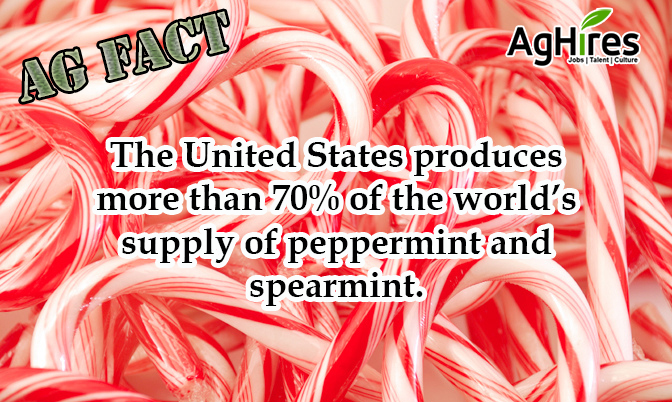
A holiday tradition, candy canes have been around for more than 350 years. The popular peppermint flavor of the candy is made possible by the farmers that work year-round to produce the mint oil. The United States produces more than 70% of the world’s supply of peppermint and spearmint. Oregon, Washington, Idaho, Indiana, California and Wisconsin are the top peppermint producing states while Washington, Oregon, Indiana, Idaho and Michigan are the top spearmint producing states.
Growing and Harvesting Mint
Mint does not produce seeds, instead new fields are planted with underground runners, called stolons, from existing plants. While mint begins as a row crop, by the second year the plants actually spread with stolons. Fields are usually rotated with another crop every 3 to 5 years, which means the cycle begins again.
Mint is planted in late March or early April and matures between July and September. The crop requires about 60 inches of rainfall. Oil is produced when exposed to sunlight and is stored in glands underneath the leaves.
When the plants are mature enough they are mowed with a windrower leaving mounded hay. Once cut, the leaves are dried for 24 to 36 hours, then picked up and blown into tubs. The oil is then extracted from the mint leaves using steam distillation.
Exacting the Oil
To exact the oil from the mint cut leaves, steam is forced through tubes in the bottom of the tub, as it rises through the hay the oil is vaporized. The vapors then pass through a vapor line at the top of the mint tub. The vapors containing the oil is channeled to water-cooled condensers to return the oil to a liquid state and then is put into 55-gallon drums.
To put it all into perspective, an acre of mint produces approximately 70 pounds of oil, while one pound of oil can flavor about 40,000 sticks of gum or 1,500 tubes of toothpaste. Or think about it this way, one drum of oil can be used to flavor about 5 million sticks of gum or about 400 thousand tubes of toothpaste.
Next time you’re enjoy a candy cane or enjoy a peppermint mocha, remember that it all started in a field.
Want more Agriculture Facts? Click here
Follow us on Facebook and Twitter to get your weekly dose of Ag Facts.
Sources:
The Wisconsin Mint Industry
Beyond Fresh Breath: Mint Trivia and Fun Facts
Oregon State University
University of California Division of Agriculture and Natural Resources






